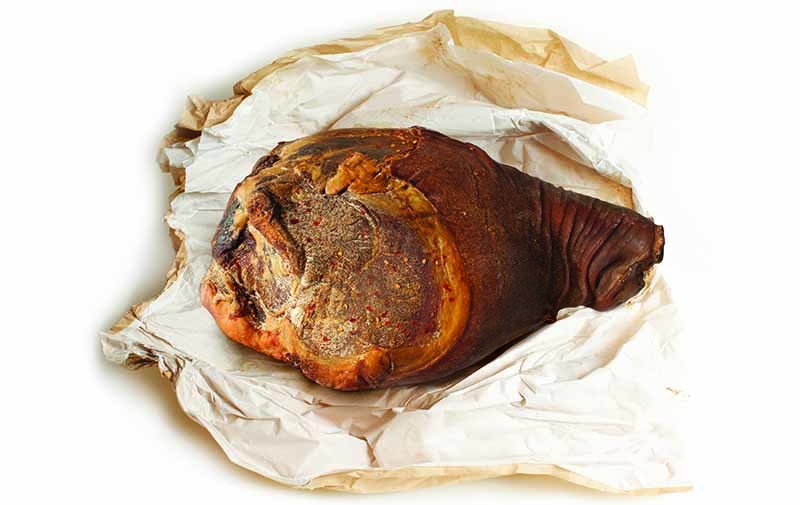
“There is never just one seductive compound in a food,” notes food writer and pork authority Peter Kaminsky in his book Pig Perfect. “More likely there are hundreds. …Therein lies the allure in the enormous complexity of cheese and ham.” Kaminsky goes on to compare the subtle interplay of tastes and aromas in these foods to the genius of Beethoven and Bach in their exquisite variations of the chromatic scale.
Of course he’s not talking about your average processed cheese or deli ham. Those sandwich-friendly slices will fill you up but hardly leave you rapturous. It’s the handmade, long-aged, patiently coaxed products that Kaminsky croons about.
As with cheese, European pork producers have long had a monopoly on the artisan market with such standouts as prosciutto, serrano, and jamón ibérico. But just as American specialty cheese has ascended the food ranks, so too have domestic country hams—in particular the hunky Southern-style favorites. Made with a dry-cure method, these hams begin with the hind leg of a pig, which is salted and aged for at least three months and up to two years. The younger versions are mild and moist. Longer curing intensifies the complexity of the flavor and the density of the texture (and also increases the price). By contrast, the more familiar kind of “city” cooked ham sold at deli counters or brought to the table dotted with pineapple rings and red cherries is wet cured: the legs are injected with brine, a process that adds 10 to 40 percent water weight, and are ready to sell in 48 hours. Lacking the robust and almost sweet porkiness of their country cousins, these ubiquitous convenience hams are partly to blame for what Kaminsky calls America’s “lost taste of pork.”
Credit for its revival goes to a handful of domestic artisans who’ve restored the traditional, time-consuming craft of making country ham and even improved on it (see sidebar). They start with pigs that have plenty of intramuscular fat, heavily marbled heritage breeds such as Berkshire and Mangalitsa. Once the hams are salted and hung to dry, explains Sam Edwards, whose family has been in the business for three generations, the curing process is very hands-on: “Small producers like us smell, taste, and touch every step of the way, making adjustments to adapt to specific conditions so every ham is as good as it can be.”
Some country hams are smoked, and seasoning blends are proprietary; they may or may not contain sugar. Younger hams are sold cooked, typically at a slow and low simmer, but those left to hang for 14 months or more can be eaten thin-sliced and raw like their European counterparts. Variations in humidity and wild bacteria mean that many of these hams express regional style and local terroir. Here’s where to find some of the best:
Benton’s Smoky Mountain Country Hams
Tennessee
Whole ham (approx. 16 lbs), unsmoked, deboned, and sliced, $64.00
Bronts Country Hams
Kentucky
Whole hams (13–17 lbs), uncooked, $50.90–$68.90
1.5 lbs (three 8 oz packages), sliced, $13.50
Finchville Farms
Kentucky
Whole ham (13–15 lbs), uncooked and sliced, $78.00
Country ham box, three 1 lb packages, cooked and sliced, $58.00
Johnston County Hams
North Carolina
Half country ham (approx. 6 lbs), uncooked, three-month cure, sliced, $39.95
Country ham (eight 8 oz packages), cooked and thin-sliced, $59.95
Newsom’s Country Hams
Kentucky
Whole country ham (15–20 lbs), uncooked, $5.60 per lb
S. Wallace Edwards & Sons
Virginia
Virginia ham (1 lb), smoked and sliced, $29.95




